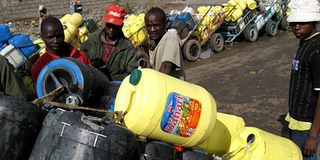Water rationing in the middle of plenty

Even with the current rainfall, the city is still experiencing water rationing. These residents of Kiang'ombe line up to draw water from a tap in Embakasi, Nairobi. Photo/FILE
Property worth millions of shillings was destroyed by flood waters on Tuesday as the long rains season set in.
Scores of animals were swept away and even an elephant research station in Samburu District was not spared by the raging waters.
Weathermen, who were marking the World Meteorological Day, warned of more destructive floods. Ironically the theme for their celebrations this year is ‘‘safety and well being.’’
At the weekend, two people were swept away by River Athi in Machakos, while on Monday, two more were drowned in River Tana, as a third went missing.
The Kenya Meteorological Department on Friday warned Kenyans of heavy flash floods as the long rains season sets in.
In its seven-day weather forecast, the department had warned of increased rainfall.
These events, the weathermen said, may lead to enhanced surface runoff. It is this runoff the department has been advising Kenyans to harvest, since the onset of the short rains in October.
However, most of the plans to harvest water were still on the drawing board as late as last week.
Face shortages
Although the main source of water for Nairobi, Ndakaini Dam, for example is about 98 per cent full and expected to fill up completely by the end of the week, city residents will continue to experience water shortages indefinitely.
The other source of water for Nairobi is Sasumua Dam, which holds a limited amount because it is still under construction.
At a water meeting in Nairobi, last week, the PS in the ministry, Mr David Stower, said completion of Sasumua’s repairs will bring significant relief for city residents.
The dam, he says, will be able to hold an extra 12 million cubic metres of water. Sasumua is Nairobi’s second largest supplier after Ndakaini, which accounts for more than 70 per cent of supply.
Sasumua dam provides Nairobi with 15 per cent of its water requirementsBut this enthusiasm is not shared by the Nairobi Water Company.
“Even if all the dams are full including Ruiru and Kikuyu, water in Nairobi will continue to be rationed because the daily yield from the dams is much below the demand,” Mr Mbaruku Vyakweli, spokesman for the Nairobi Water Company, told the Nation on Tuesday.
Another dam
He said discussions are on between the Ministry of Water and the Athi Water Services Board on the possibility of establishing another dam to supply water to Nairobi in Maragua, central Kenya.
This could form part of the ministry’s strategy to construct 25 large dams across the country in the next 10 years.
This means a Nairobi child who starts class one today may live with water rationing until they are in Form Two, around the year 2020.



